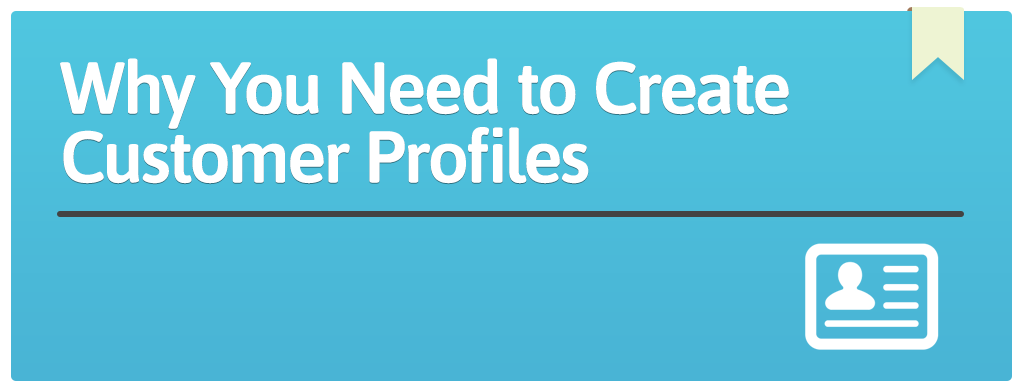
If you search for ways to market your SaaS, you’ll see the same piece of advice over and over: Understand your customer.
It’s good advice, but many SaaS founders never take it to heart. They figure “I know who I’m selling to. I’ve got this covered.” Unfortunately, few have actually put in the work.
The first step to truly understanding your customer is to create a customer profile.

A customer profile is a group of information that represents typical customers. Profiles are sometimes called “personas.” They are used to consolidate learning and help you understand who you’re selling to. They should exist as a fluid, living document that is referenced and adjusted over time.
Depending on your type of business, you may have one customer profile or many. Niche products have one or two profiles. Versatile products could have five or ten profiles. (If you find yourself creating dozens of customer profiles, you’re probably drilling down too deep.)
Customer profiles are generated from research, either through analytical data or customer interviews. Often a profile is given a human name that aligns with the customer it represents. This helps the profiles feel like real customers the company wants to attract and retain.
The profile should include the following information:
- Demographical data (age, sex, location, income, etc.)
- Business data (role in company, revenue, company size, etc.)
- Challenges and problems
- Likes and dislikes
- Why they would want to use your product
- Their personal and professional goals
- What challenges they would have with the product
- Any language/messaging that would help them see value in the product
- How to get them to realize value in the product quickly
Your profile can include any other information you think would be valuable to have on hand.
But why do we create customer profiles in the first place? How do they help you run and grow your business?
Customer profiles make communication easier
Why is it easier to talk to your friends than strangers? It’s because you have common ground. You know what they like. You know which topics to avoid. You know which words are appropriate for your relationship.
With strangers, you’re searching in the dark. Each conversation is an attempt to learn, not an attempt to add value. Plus, you have to be careful that you don’t offend or disappoint, which erodes the quality of the conversation.
A customer profile helps you understand the customer so you can have a meaningful relationship. You’ll be able to push through that stranger phase quickly, even during the first interaction with the customer.
“The better you know your audience, the more effectively you can create appealing content ideas, make formats decisions, handle positioning and placement, and promote the content,” says Jayson DeMers, an online marketing expert.
Most importantly, a profile puts all of your knowledge about the customer in an easy-to-access place so your whole organization can benefit from the learning. When the new employee needs to create a customer-facing document or get on the phone with a customer, they can examine the profile so they can engage with the customer smartly.
Customer profiles create a better product
Building the best product means arming yourself with as much information as possible. You need to know what your customers want and how they want it.
You can get a lot of information from your analytics, but at some point, you’ll have to gather qualitative data from your customers. Whether you do that through surveys delivered through your application or by actually calling customers on the phone, you need that data as often as you can get it.
Through these interactions, you’ll initially create and develop your customer profiles. As the profiles become more sophisticated, you’ll have more information you can use to improve your product. Each note is a potential insight that can lead you to develop a better product.
Customer profiles create loyalty
Customers who maintain strong relationships with brands are less likely to turn to competitors, even if those competitors offer an objectively better service.
By using the right messaging, offering the right pricing, delivering the right offers, and creating a product your customers want, you’ll develop a relationship that gets harder and harder to break over time. Eventually, your product will become so ubiquitous to them that they’ll stop investigating competitors all together.
Customer profiles let you segment your marketing
In many cases, businesses have multiple customer groups that require different marketing, pricing, or messaging. If you’re one of those businesses, you’ll need a customer profile for each segment. In some cases, you could need many customer profiles.
For example, a website for a college would have different types of traffic. Current students, prospective students, parents of students, alumni, faculty, and investors would all use their site, so the college would be smart to consider each group with a customer profile. The school could even go deeper with profiles for different types of faculty (maintenance, administrators, teachers, etc.) and students at different progression levels.
In the case of a SaaS product, you might segment your customers by company size, role in the company, or any other variable that seems reasonable. Once you understand your segments (and the differences between them), you can tailor the messaging to match. For example, you would only send tips via email for enterprise features to your enterprise customers.
Customer profiles bring in more customers

This is really the biggest benefit of creating customer profiles. More customers means more revenue and more profit.
When you know what your ideal customer looks like, you can bring in new ones in three ways.
1. You can go to the places your customers spend time.
If they use a specific forum, you should participate on the forum. If they read a particular blog, you should contribute to that blog. If they follow someone influential on Twitter, you should connect with that influencer and get them to promote you.
Furthermore, understanding your customer makes cold pitching easier. There’s no reason to spend time or resources pitching your product to customers who will never buy. Instead, you can cut out the leads that will never turn into revenue and spend your time focusing on the ones that will.
2. You can attract new customers quickly.
Once new customers become aware of your product, they’ll quickly move through their decision-making process. Your customer profile has given you the knowledge to remove their barriers.
For example, if your customer research shows that your customers are willing to spend about $100/month for a product like yours, you can make pricing a non-issue for new customers.
3. Well-fit customers are more likely to refer you to new customers.
People who like your product are more likely to refer you to their friends and colleagues. Your goal is to find the customers who fit your product the best so they’ll do the selling for you. If you focus on only the best customers for your product, you’ll create an ongoing loop of referrals that scales quickly.
Final thoughts
In short, you need customer profiles because they help you grow your SaaS. They indirectly support all of your growth goals and marketing tactics. Without them, you’ll lack the proper tools to communicate with your customers effectively, and after all, marketing is just communication.

